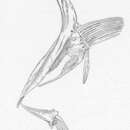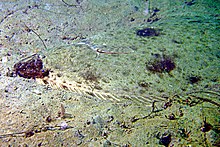en
names in breadcrumbs


California halibut live for up to 30 years in the wild. A study has shown that California halibut are generally older in Southern California, as opposed to Central California. Little is known about their longevity in captivity.
Range lifespan
Status: wild: 30 (high) years.
Juvenile California halibut may be preyed upon by shorebirds, waterfowl, and larger fishes while they reside in shallow bays. Adult California halibut in coastal regions are fed on by Pacific angel sharks, Pacific electric rays, California sea lions, and bottlenose dolphins. In some cases, larger halibut are known to feed on their smaller counterparts.
In order to avoid predators, California halibut bury themselves in the sand and use their camouflage abilities to blend in with the sea bottom. Due to their well-developed swimming abilities, they are also able to escape from some of their predators even if they are detected.
Known Predators:
Anti-predator Adaptations: cryptic
California halibut are large, oval-shaped flatfish, with a symmetrical mouth and sharp, canine-like teeth. They have long gill rakers and relatively small eyes. Olfactory rosettes and cephalic lateralis pores are found on their snout and jaw, respectively. At the beginning of the larval stage, one eye is on each side of the head. As individuals mature into the postlarval stage (at 20 to 29 days), one of the eyes migrates to the other side, leaving the animal with 2 eyes on the 'dorsal' side (which technically is still its lateral side). The body is firm, with paired pectoral fins and a wide caudal fin, which is used for rapid propulsion. Coloration is normally brown to brownish-black on the dorsum, and white on the ventral side. The chromatophores in the skin are capable of changing the animal's color and patterning to match its environment. The lateral line is arched above the pectoral fin. California halibut reach a maximum size of 152 cm and a mass of 33 kg.
California halibut may be confused with Pacific halibut (Hippoglossus stenolepis). These two species can be distinguished by the length of the maxilla, which reaches beyond the eye in California halibut (versus just reaching the front edge of the eye in Pacific halibut), and the number of dorsal fin rays, which is always less than 77 in California halibut (versus 80 or more in Pacific halibut).
Range mass: 33 (high) kg.
Range length: 152 (high) cm.
Other Physical Features: ectothermic ; heterothermic ; bilateral symmetry
Sexual Dimorphism: sexes alike
California halibut are a benthic species that inhabits sandy bottoms to depths of 183 m. They congregate in the nearshore waters and embayments of California.
Juveniles live in nursery bays and migrate to sandy areas along the coast as they grow. Males mature faster than females, and leave nursery areas for the open coast at 2 to 3 years of age and 20 to 23 cm in length, while females migrate as slightly larger sub-adults, at a length of around 25 cm.
Range depth: 183 (high) m.
Habitat Regions: temperate ; saltwater or marine
Aquatic Biomes: benthic ; coastal ; brackish water
Other Habitat Features: estuarine
California halibut are found along the Pacific coast of North America, ranging from the Quillayute River, Washington, to Baja California, Mexico.
Biogeographic Regions: nearctic (Native ); pacific ocean (Native )
California halibut are carnivorous, with their diet changing in association with growth. They feed both during the day and night, but appear to favor catching prey during the day. Juveniles (less than 55 mm) feed mainly on small crustaceans, such as harpacticoid copepods, small gammarid amphipods, and mysid shrimps. As they grow to 55 to 230 mm, they feed on shrimp and small fishes, such as gobies, topsmelt (Atherinops affinis), and California killifish (Fundulus parvipinnis). As juveniles grow and migrate out of protected bays, their diet switches yet again, to larger, faster-swimming prey. Young adult and mature California halibut are known to feed on northern anchovies (Engraulis mordax) and mysids.
Halibut partially or completely bury themselves in the sand (leaving the eyes exposed) to hide from their prey. They wait and watch the prey item until it is less than three head lengths away, and then strike with a swift upward lunging motion, snatching it. If the strike fails, they will chase the prey until it is captured.
Animal Foods: fish; aquatic or marine worms; aquatic crustaceans; zooplankton
Primary Diet: carnivore (Piscivore , Eats non-insect arthropods); planktivore
California halibut play a crucial role in the neritic food chain, as they are a vital source of food for predators, in addition to being secondary and tertiary consumers themselves.
Mutualism and commensalism between this species and others has not been observed, but it is known to host a number of endo- and ectoparasites. Known endoparasites include flukes, tapeworms, and nematodes, which infest the intestinal tract. Ectoparasites include copepods and isopods, which attach themselves to the gills and scales.
Commensal/Parasitic Species:
California halibut are widely sold and consumed by humans. The species has supported recreational and commercial fisheries throughout the west coast of North America since the early twentieth century. According to the Department of Fish and Game, 239,558 kg of California halibut were landed in 2010. The total value, computed from prices paid to fishermen, was estimated at $2,347,179.
Positive Impacts: food
California halibut have not been known to cause any significant problems or harm to humans. However, they have very sharp teeth and will potentially bite, if handled.
Negative Impacts: injures humans (bites or stings)
Larvae hatch at about 2 mm in length, and undergo a change in form 20 to 29 days post-hatching, after which they settle to the bottom of bays when the larvae attain sizes between 7.5 to 9.4 mm. Paralichthys californicus is unique in that 20 to 29 days after its larval stage, one of its eyes migrates to the same side as the other eye. It can either be dextral or sinistral, meaning that both the eyes may be located on the right or left side of its head.
Development - Life Cycle: metamorphosis
In 2011, the California Department of Fish and Game completed its first stock assessment of the California halibut population in Southern California. An independent panel review found numerous problems with inadequate sampling and other deficiencies in the data provided by this assessment, but nonetheless found that the population was depleted to about 14% of its unexploited level, and noted that recruitment had declined sharply since 1999. However, no conservation initiatives have yet been enacted for this species.
US Federal List: no special status
CITES: no special status
State of Michigan List: no special status
Communication in California halibut has not been extensively studied or observed. They are able to use their lateral line to detect vibrations in the water, aiding in prey location and predator avoidance. Because one of the eyes migrates to the other side of the head, and because the eyes are sensitive to patterns, they are able to lay flat on the bottom of the ocean, camouflaging themselves and enabling them to better spot their prey. This species is also able to sense chemical cues in the water, using the olfactory rosettes found in its nares.
Perception Channels: visual ; tactile ; acoustic ; vibrations ; chemical
California halibut reproduce by broadcast spawning in shallow waters of coastal areas; eggs are fertilized externally.
Mating System: polygynandrous (promiscuous)
Males become sexually mature at 2 to 3 years of age and a standard length of 20 to 23 cm. Females mature later, at 4 to 5 years and 38 to 43 cm in standard length. Spawning season occurs from February to August, most commonly taking place in May. California halibut eggs are 0.7 to 0.8 mm in size and are mainly found close to the shore, in shallow water between 12 and 45 m.
Breeding interval: California halibut breed once yearly.
Breeding season: Spawning may occur from February to August, but most commonly happens in May.
Average number of offspring: 420,000 eggs.
Range age at sexual or reproductive maturity (female): 4 to 5 years.
Range age at sexual or reproductive maturity (male): 2 to 3 years.
Key Reproductive Features: iteroparous ; seasonal breeding ; gonochoric/gonochoristic/dioecious (sexes separate); sexual ; fertilization (External ); broadcast (group) spawning; oviparous
There is no parental investment, as this species is a broadcast spawner with planktonic larvae.
Parental Investment: no parental involvement
The California halibut or California flounder (Paralichthys californicus) is a large-tooth flounder native to the waters of the Pacific Coast of North America from the Quillayute River in Washington to Magdalena Bay in Baja California. It feeds near shore and is free swimming. It typically weighs 6 to 30 pounds (3 to 23 kg). It is much smaller than the larger and more northern-ranging Pacific halibut that can reach 300 pounds (140 kg).
This is an unusual fish in that one eye has to migrate around from one side to the other as it grows from an upright fry or baby fish into an adult fish that lies on its side. The adult has two eyes on the up-side as it lies on the bottom. Most flatfish are generally either right-eyed or left-eyed, but the California halibut is unusual in having a roughly even number of each type. Like other flatfish, the halibut hides under sand or loose gravel and blends into the bottom.
 A well camouflaged California halibut
A well camouflaged California halibut The California halibut or California flounder (Paralichthys californicus) is a large-tooth flounder native to the waters of the Pacific Coast of North America from the Quillayute River in Washington to Magdalena Bay in Baja California. It feeds near shore and is free swimming. It typically weighs 6 to 30 pounds (3 to 23 kg). It is much smaller than the larger and more northern-ranging Pacific halibut that can reach 300 pounds (140 kg).
This is an unusual fish in that one eye has to migrate around from one side to the other as it grows from an upright fry or baby fish into an adult fish that lies on its side. The adult has two eyes on the up-side as it lies on the bottom. Most flatfish are generally either right-eyed or left-eyed, but the California halibut is unusual in having a roughly even number of each type. Like other flatfish, the halibut hides under sand or loose gravel and blends into the bottom.